Blog
-
How to make my bot more humanlike
I am building my own chatbot and the main objective is to make it as indiscernable from a human in a texting setting ( the bot is speaking to someone via whatsapp ). How can I prompt the AI to be more humanlike. The word “colloquial” as brought me some succes, but I want to get even deeper and better. Thanks for your answers.
submitted by /u/ArmFalse221
[link] [comments] -
Want to create chatbot for 200+ APIs
Hi all,
I am looking to create a chatbot for my organization. The chatbot is supposed to run for 200+ data migration APIs in the backend. The chatbot should understand which API user wants to run from prompt and if there are any parameter requirement or request body entry requirement then chatbot should ask for them.On providing the entries the chatbot should display the result of the API.
The organization policy dictates to not use online services so data remains safe. So I need se software that I can use locally(by downloading it) to build this chatbot. I am also allowed to use microsoft azure for this but I haven’t worked on it ever.
Can anyone please help me with this requirement.
submitted by /u/Tasty_Huckleberry_52
[link] [comments] -
What is a good nsfw version of character.ai?
Here’s what I’m looking for:
- Unlimited texts for free (just texts!)
- and nsfw
- Able to roleplay as an A.I. wife that I can occasionally be spicy with.
- I don’t care about voices and images. So if those are behind a pay wall, I’m okay with that.
- maybe if I can talk to her with my mic, that’s cook. But not my priority.
submitted by /u/PAfb_640_Hentai
[link] [comments] -
Handle Long Pause Between Bot Responses Using Dialogflow

Why does audio need to be included in interactions between users and bots?
In a conversational AI-enabled voice bot, in case of obtaining data from a database or requesting information from LLM models like ChatGPT, Claude, Gemini, or LLaMA, there’s inevitably a delay while waiting for updates or responses, often leading to an awkward pause in the interaction. To address this issue effectively, we implemented audio cues as a means to confirm the arrival of the response, ensuring a smoother interaction between the user and the Bot. If a response is received, it’s promptly displayed; otherwise, we persistently loop the audio to attempt retrieval again.
How do we add audio until we get the response?
Here’s a step-by-step guide:
1. Dialogflow Setup
Sign in to the Dialogflow CX console and create a new agent. Give the Agent name as you like. You will find the below screen for the new agent:
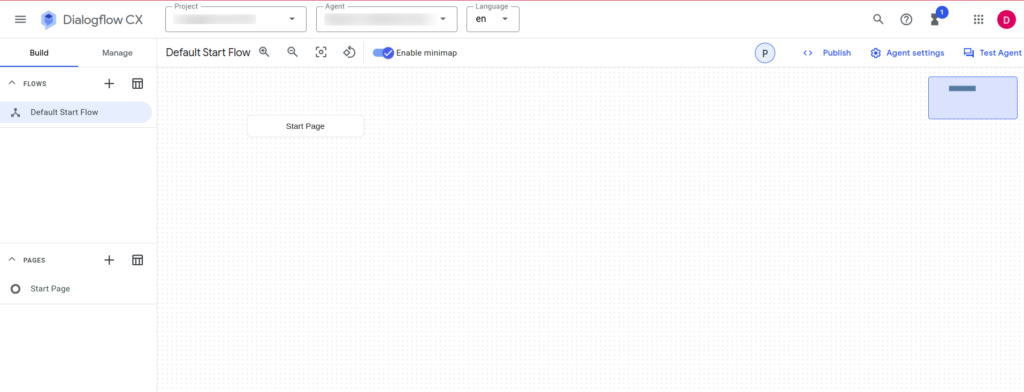
Now navigate to ‘Start Page’. Click on the ‘Default Welcome Intent’ and add a new page of a name you like we have used ‘page_1’. Click on the Save after adding a new page.
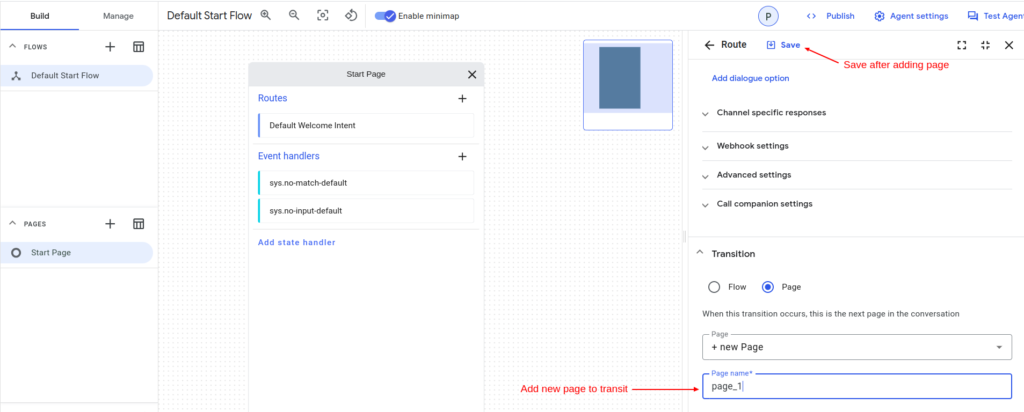
Navigate to ‘page_1’. Click on the Routes to add a new route and create a new intent ‘intent_1’.

In ‘intent_1’, add Training Phrases like ‘I want to increase the webhook’ and Save the intent.
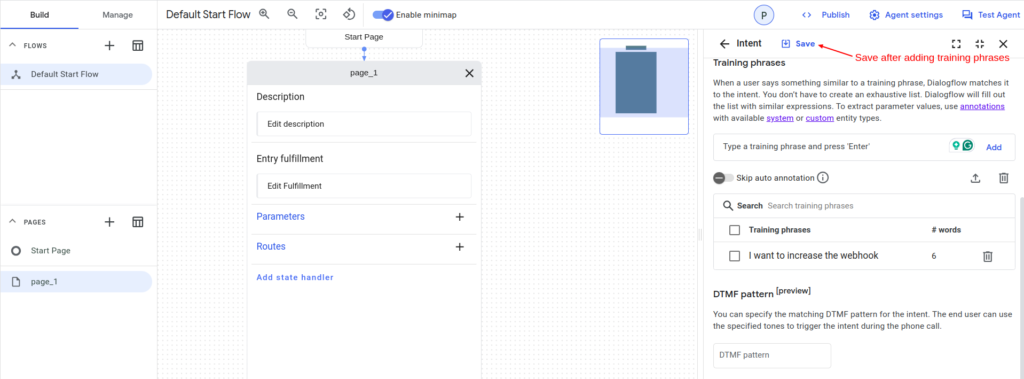
Now, Enable webhook (create webhook if not created) and add webhook with tag ‘response’. Most importantly, enable ‘Return partial response’. Add a new page ‘page_2’ and Save after adding a new page.
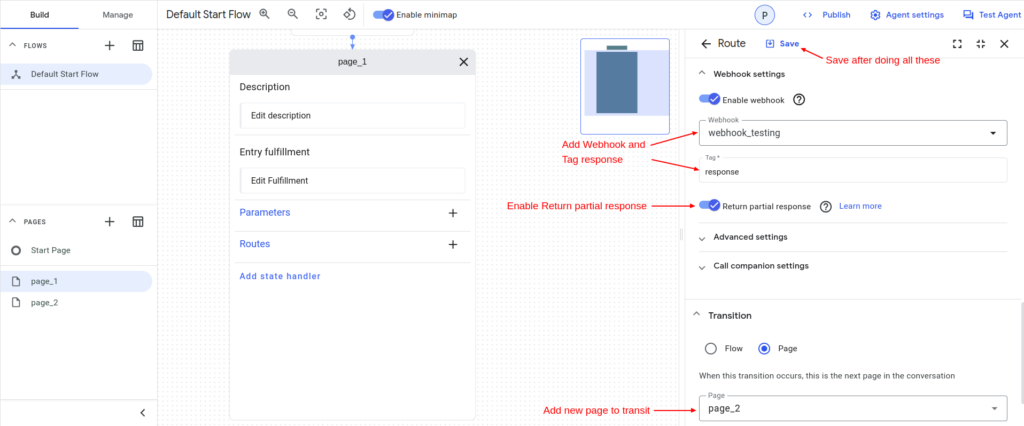
Again add a new route in ‘page_1’. In Condition, add a parameter ‘$session.params.text = True’ and Save after adding a parameter.
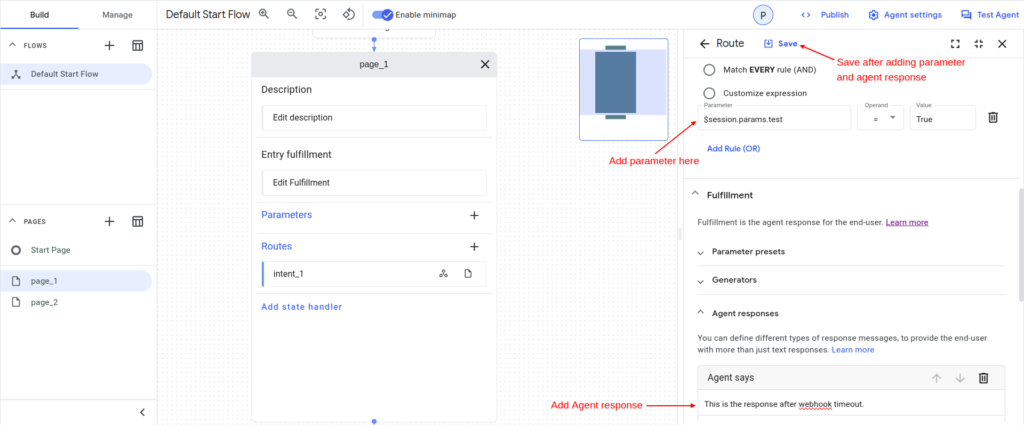
Again add a new route in ‘page_1’. In Condition, add a parameter ‘$session.params.text = False’.
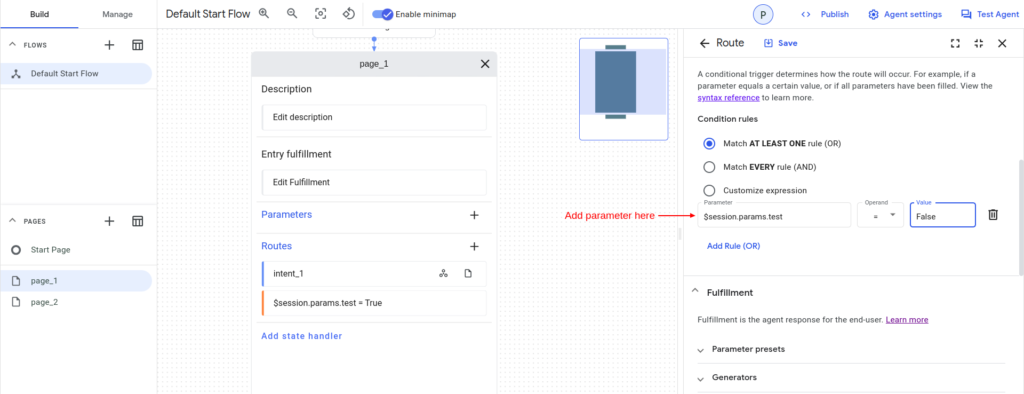
Now, Enable webhook and add webhook with tag ‘response_new’. Most importantly, enable ‘Return partial response’. Add a new page ‘page_2’ and Save after adding a new page.
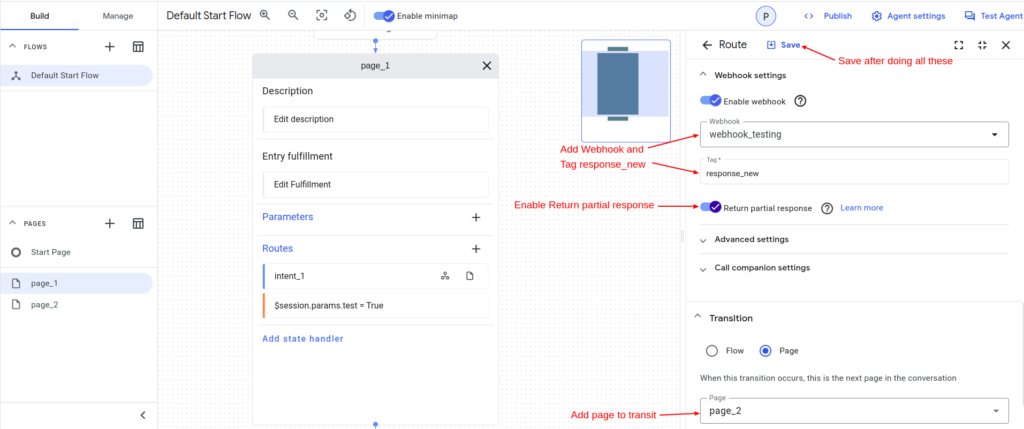
Navigate to ‘page_2’. Click on the Routes to add a new route and add a parameter ‘$session.params.text = False’.

Now, Enable webhook and add webhook with tag ‘get_response’. Most importantly, enable ‘Return partial response’. Add a previous page ‘page_1’ and Save after adding a previous page.
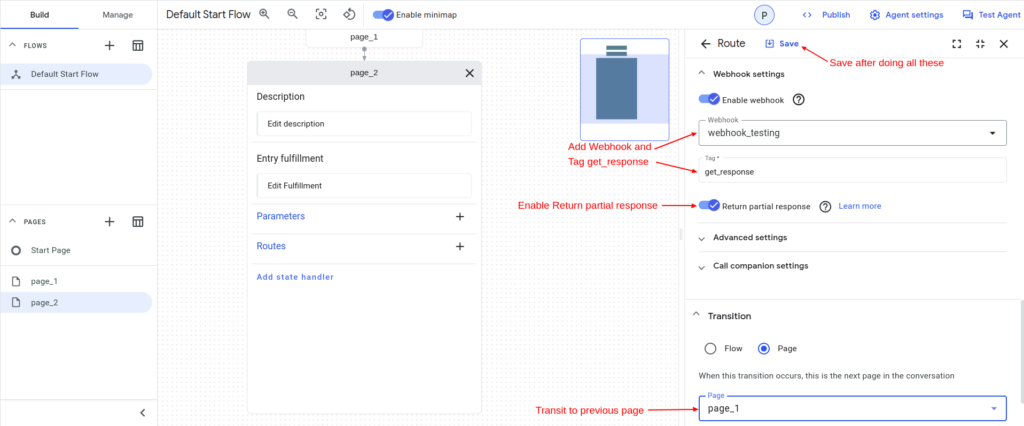
2. Webhook Code
from flask import Flask, request, jsonify
import time
from datetime import datetime, timedelta
import _thread
app = Flask(__name__)
# Webhook endpoint to handle POST requests
@app.route('/webhook', methods=['POST'])
def webhook():
# Get the JSON data from the request
data = request.get_json(silent=True, force=True)
# Extract the tag from the JSON data
tag = data["fulfillmentInfo"]["tag"]
if tag == 'response':
# Start a new thread to execute parameters_sending function
_thread.start_new_thread(parameters_sending,())
print("started...")
# Prepare the response JSON
reply = {
"fulfillmentResponse": {
"messages": [
{
"text": {
"text": [
'''<speak>Please Hold a line <audio src="https://commondatastorage.googleapis.com/codeskulptor-demos/pyman_assets/intromusic.ogg"></audio>
</speak>'''
]
}
}
]
},
"sessionInfo": {
"parameters": {"test": "False"}
}
}
return jsonify(reply)
if tag == 'response_new':
# Similar response for a different tag
return {
"fulfillmentResponse": {
"messages": [
{
"text": {
"text": [
'''<speak>Please Hold a line...<audio src="https://commondatastorage.googleapis.com/codeskulptor-demos/pyman_assets/intromusic.ogg"></audio>
</speak>'''
]
}
}
]
},
"sessionInfo": {
"parameters": {"test": "False"}
}
}
if tag == "get_response":
# Simulate delay and then fetch content from a file
time.sleep(4.5)
print("entering get response")
with open("user_name.txt", "r") as file:
content = file.read().strip()
print(content)
if content:
# If content exists, prepare response with the content
reply = {
"fulfillmentResponse": {
"messages": [
{
"text": {
"text": [
f'Message received: {content}'
]
}
}
]
},
"sessionInfo": {
"parameters": {"test": "True"},
},
}
# Clear the content of the file
with open("user_name.txt", "w") as file:
file.write("")
return jsonify(reply)
else:
return {
"sessionInfo": {
"parameters": {"test": "False"},
},
}
# Function to perform a background task
def parameters_sending():
time.sleep(20)
print("completed")
# Write a message to a file
with open("user_name.txt", "w") as file:
file.write("Your Testing Is Successfully Executed.")
# Main function to start the Flask app
if __name__ == '__main__':
app.run(debug=True)3. Twilio Integration
We have already made the Blog on integrating Twilio in Dialogflow CX. Please check the Blog Integrating Twilio With Dialogflow CX To Enable Voice Calls and follow the steps to complete the integration.
For a practical demonstration of this technique, you can view a recorded demo here:
This video will showcase how audio cues seamlessly fill the gaps while the bot retrieves information, creating a smoother user experience.
Conclusion
By implementing audio cues and utilizing Dialogflow CX’s return partial response feature, we can significantly improve the user experience during interactions with bots that involve waiting for data or responses from external systems. This approach helps bridge the silence during pauses and keeps the user engaged in the conversation.
Originally published at Handle Long Pause Between Bot Responses Using Dialogflow on April 17, 2024.
Handle Long Pause Between Bot Responses Using Dialogflow was originally published in Chatbots Life on Medium, where people are continuing the conversation by highlighting and responding to this story.
-
❤️😋

The school was very beautiful❤️
submitted by /u/Far_Customer815
[link] [comments] -
Unlocking Website Engagement: Implementing AI Chatbots with the Ionic Framework
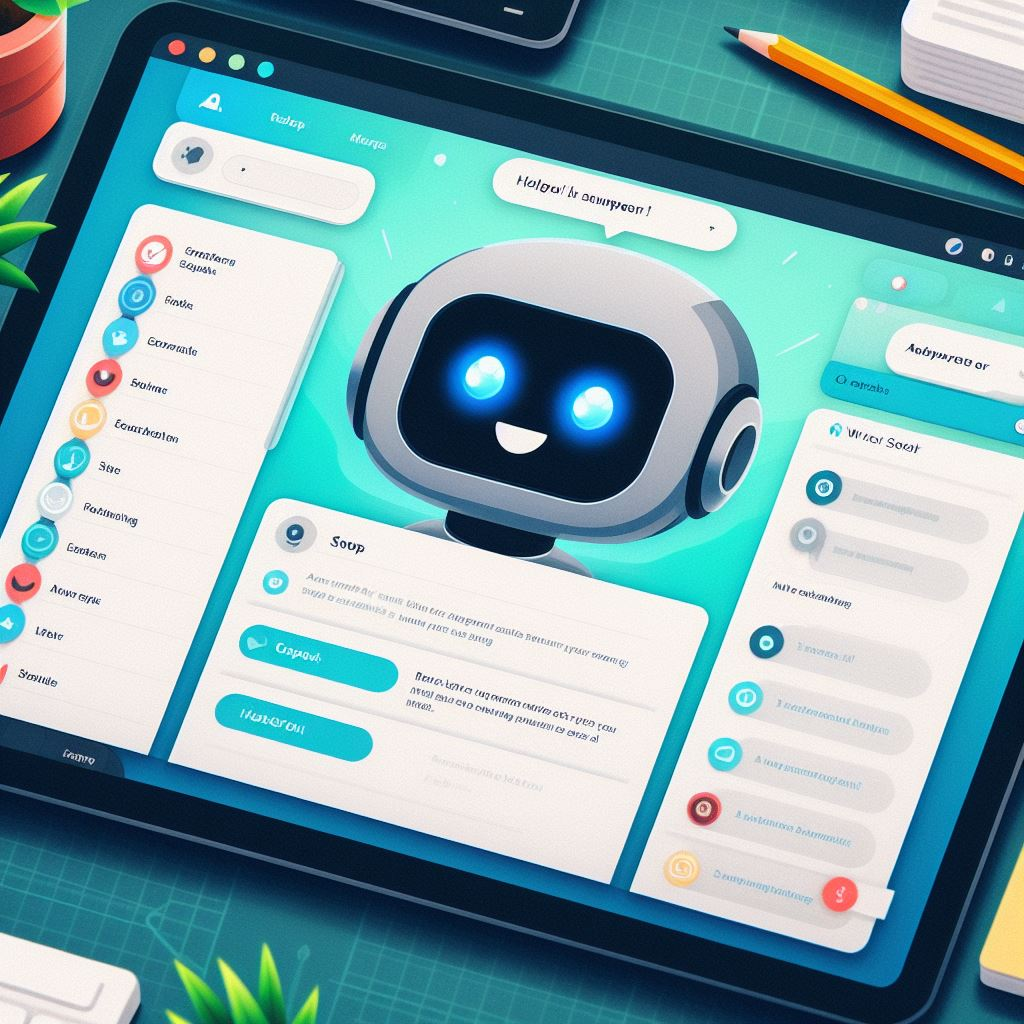
Unlocking Website Engagement with Chatbot Website engagement is key to driving user interest in your product and moving them toward conversion. One bad experience and the user is out and is on your competitor’s website. One of the ways to increase the quality of engagement is the integration of an AI chatbot on the website. With the rise of generative AI models like ChatGPT, Gemini and others, these chatbots can now perform various generative AI models like ChatGPT, Gemini, and others, these chatbots can now perform various tasks such as:
- Providing Instant Support: AI chatbots can offer immediate responses to user queries, resolving issues in real time and improving customer satisfaction.
- Personalized Recommendations: By analyzing user behavior and preferences, AI chatbots can suggest products or content tailored to individual needs, enhancing the user experience.
- Gathering User Feedback: Chatbots can conduct surveys and collect feedback, providing valuable insights into user preferences and areas for improvement.
- Assisting in Navigation: They can help users find information quickly by guiding them through the website, reducing frustration and increasing engagement.
- Handling Transactions: AI chatbots can facilitate seamless transactions, from booking appointments to making purchases, thus streamlining the user journey.
The Ionic Framework: A Perfect Fit for Chatbots
The Ionic Framework is an open-source SDK for hybrid mobile app development, making it an excellent choice for implementing chatbots. Its cross-platform capabilities allow developers to create applications that work seamlessly on both iOS and Android, as well as the web. Key features of Ionic that make it ideal for chatbot implementation include:
- Easy Cross-Platform Development: Ionic apps can be deployed on multiple platforms without significant changes. It comes with a suite of developer tools, including a CLI for scaffolding projects, live reload for real-time updates during development and debugging tools that make it super easy to use.
- Integration Capabilities: Ionic easily integrates with various backend services and APIs, essential for connecting chatbots with AI engines.
- Rich UI Components: Ionic provides a rich library of UI components, ensuring that the chatbot interface is visually appealing and user-friendly.
- Responsive Designs: Ionic ensures that your chatbot interface is responsive and adapts to different screen sizes and orientations. This is crucial for providing a consistent experience across smartphones, tablets, and desktops.
- Efficient Rendering: Ionic uses technologies like Shadow DOM and lazy loading to optimize the performance of your app. This ensures that your chatbot loads quickly and runs smoothly, providing a better user experience.
Steps to Implement an AI Chatbot with Ionic
Implementing an AI chatbot in your Ionic app involves several key steps. Here’s a refined guide to help you through the process:
1. Choose a Chatbot Platform
Select a chatbot platform that suits your requirements. Popular choices include:
- Kommunicate: Offers integrations with generative AI models like ChatGPT.
- Dialogflow: Google’s natural language understanding platform.
- IBM Watson Assistant: Provides robust AI and machine learning capabilities.
- Amazon Lex: AWS’s service for building conversational interfaces.
2. Create the Chatbot — Design and develop your chatbot by following these steps
- Plan Conversational Flows — Outline the interactions and user journeys your chatbot will handle.
- Build the Chatbot
- Intents, Entities, and Responses — For platforms like Dialogflow, define the intents (user intentions), entities (data to extract), and responses (what the bot says).
- Upload Documents/URLs — For platforms like Kommunicate, leverage generative AI by uploading relevant documents or website URLs to train the chatbot.
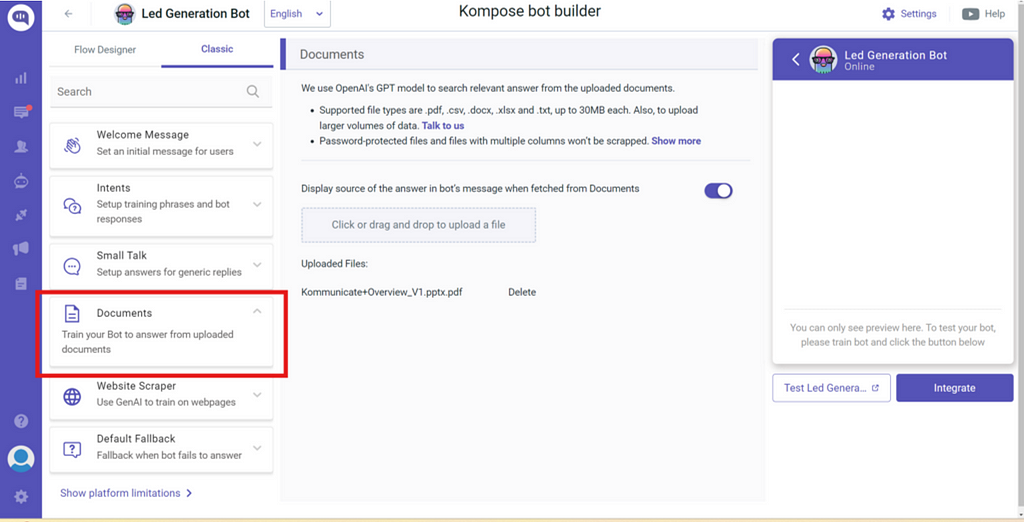
Upload Documents to Train the Chatot 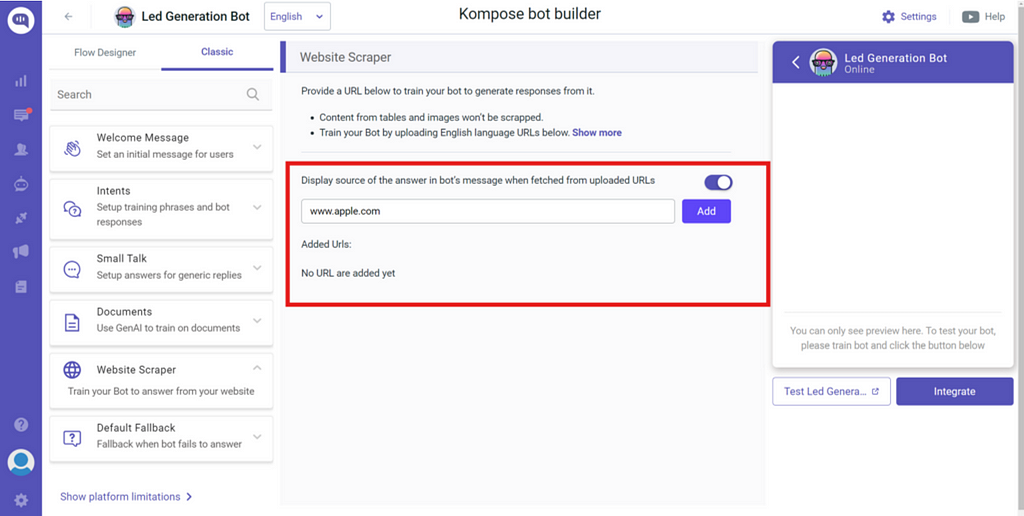
Upload Website URLs to Trian the Bot 3. Integrate with the Ionic App
Integrate your chatbot into the Ionic app by following the platform-specific instructions. Each platform provides detailed integration guides. For example, use API keys and SDKs provided by the chatbot platform to connect it with your Ionic app.
Here’s an example of an API key from Kommunicate:
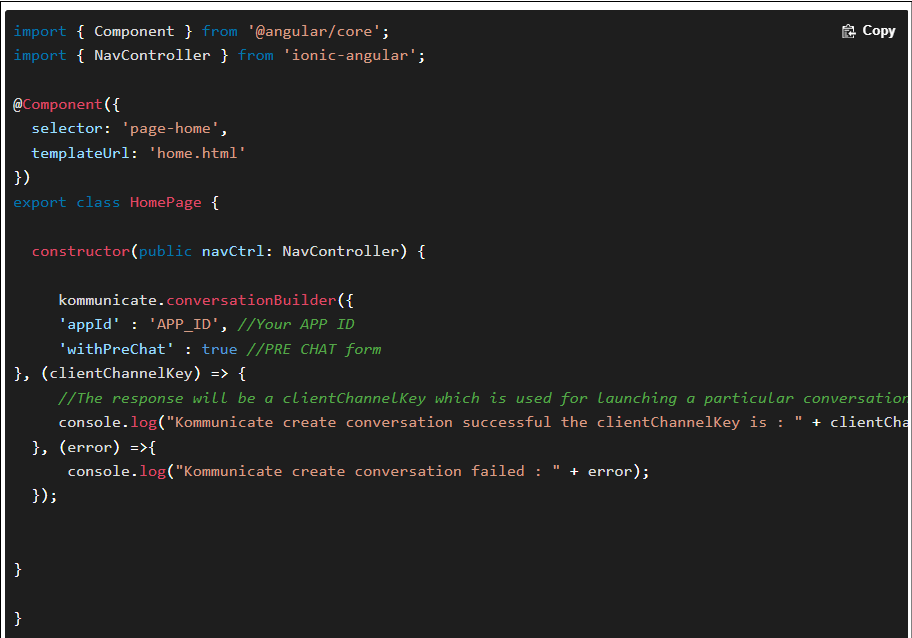
You can find a detailed step-by-step process of integrating your ionic app with Kommunicate here — https://docs.kommunicate.io/docs/cordova-installation
4. Testing
Thoroughly test your chatbot to ensure it meets your expectations.
- Simulate User Interactions: Engage with the chatbot as a user would, testing various scenarios and edge cases.
- Gather Feedback: Collect feedback from real users to identify areas for improvement.
- Iterate: Refine the chatbot’s design and logic based on the testing results and user feedback.
5. Deployment
Once you are satisfied with the performance of your chatbot, deploy it to a server or cloud platform so that it can be accessed by users of your Ionic app.
However, a couple of things need to be kept in mind as well while integrating your app with a chatbot –
💡Integrating AI chatbots into an Ionic app requires a good understanding of both the Ionic framework and the specific AI platform’s APIs and SDKs.
💡Creating highly customized and sophisticated conversational flows can be challenging and time-consuming. In this, platforms like Kommunicate can be super helpful.
💡At times, AI chatbots can be resource-intensive, potentially affecting the performance of your Ionic app, especially on lower-end devices — hence, thorough testing is required before going live.
💡Ensure that the chatbot remains compatible with new versions of the Ionic framework by regularly updating and maintaining both the framework and the chatbot integration
That’s it! By following these steps, you will have an AI chatbot ready inside your Ionic app to engage with your customers and provide a more interactive experience. Remember to stay informed about updates, test thoroughly, and continuously refine your chatbot for optimal performance and user satisfaction.
Unlocking Website Engagement: Implementing AI Chatbots with the Ionic Framework was originally published in Chatbots Life on Medium, where people are continuing the conversation by highlighting and responding to this story.
-
5 Reasons SaaS Chatbot Creators Are Trending
In a world where immediacy and convenience are at the forefront of consumer expectations, the emergence of SaaS chatbot creators has revolutionized how businesses engage with customers.
These powerful tools allow for the creation of chatbots — automated conversational interfaces that mimic human interaction to provide instant customer support, streamline processes, and personalize user experiences.
But what’s behind the surging popularity of these chatbot makers? In this deep dive, we’ll uncover the compelling reasons why SaaS chatbot creators are not just a fleeting trend but a fundamental shift in customer service technology.
What are SaaS Chatbot Creators?
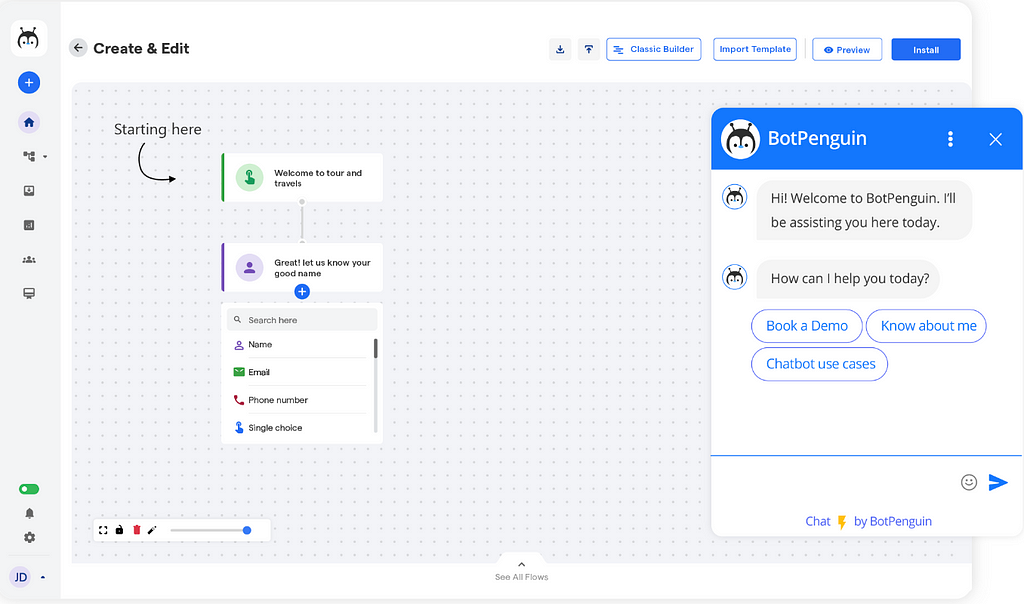
SaaS (Software as a Service)
The ‘as a Service’ model has changed the software industry by providing access to applications over the internet without the need for traditional installations or maintenance.
SaaS represents the pinnacle of this shift, offering software that’s available on demand and typically paid for with a subscription model.
Chatbots (Conversational AI Assistants)
Chatbots are AI-driven agents designed to simulate human-like conversations with users.
These AI chatbots can perform a variety of tasks, from answering FAQs to completing transactions, without the need for human intervention.
Putting it Together: Building Chatbots with SaaS Platforms
Coupling the SaaS model with chatbot technology leads to SaaS chatbot platforms — online services that enable anyone to build, deploy, and manage AI chatbot assistants with ease.
This synergy is redefining customer interaction norms as businesses of all sizes adopt SaaS chatbot creators to enhance user experiences.
The Rise of SaaS Chatbot Creators
Why SaaS Chatbots? The Benefits They Bring
24/7 Availability & Instant Support
SaaS Chatbot creators empower businesses to offer round-the-clock support. Unlike human employees, AI chatbots never sleep, ensuring immediate response times and consistent performance at any hour.
Improved Customer Engagement & Satisfaction
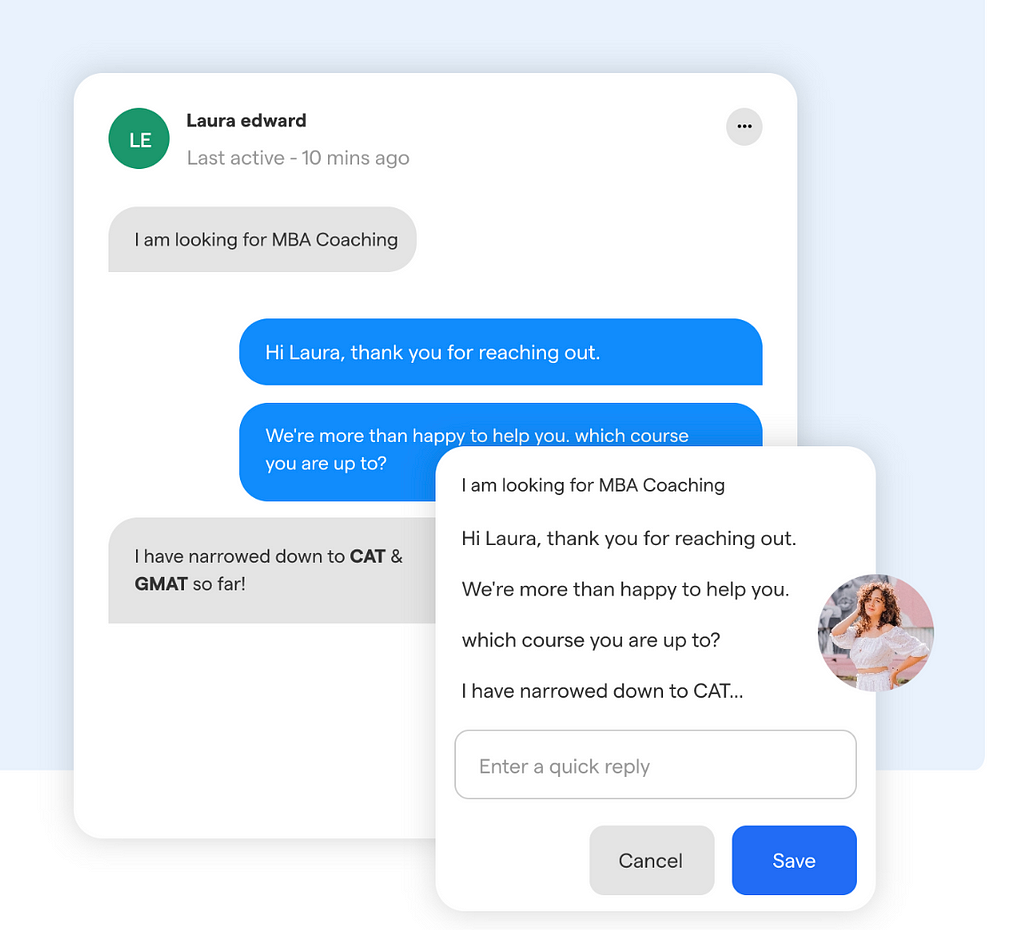
As AI chatbot technology advances, these digital assistants are becoming increasingly adept at engaging customers in a more human-like manner, boosting overall satisfaction rates.
Streamlined Workflows & Increased Efficiency
By automating routine inquiries and tasks, SaaS chatbot makers enable businesses to optimize their operations and free up human resources for more complex issues that require a personal touch.
Personalized Interactions & Targeted Lead Generation
Thanks to machine learning capabilities, AI chatbots can deliver highly personalized experiences, tailoring conversations to individual user needs and capturing leads with greater precision.
5 Reasons SaaS Chatbot Creators Are Trending
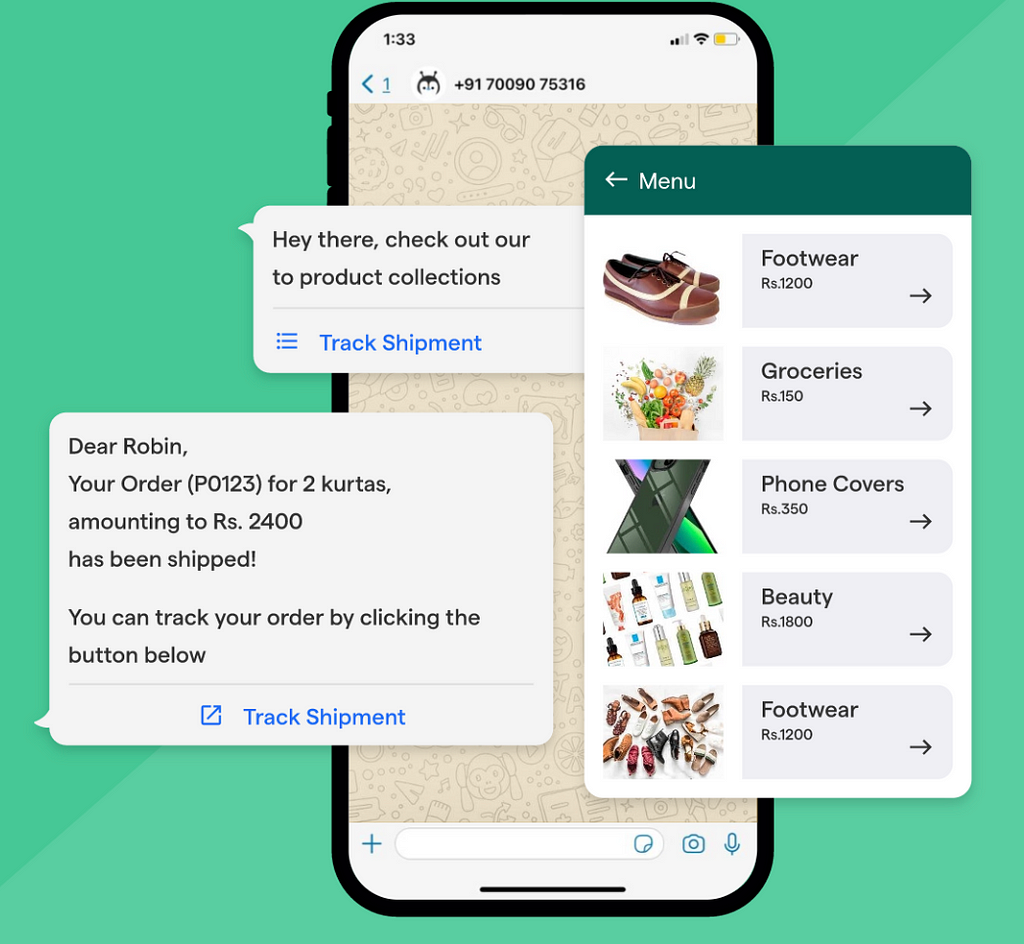
Reason 1: Easy to Use, No Coding Required
Drag-and-Drop Interfaces & Visual Builders
SaaS chatbot platforms often feature intuitive interfaces that use drag-and-drop functionality, making the creation process accessible to users regardless of their technical background.
Pre-Built Templates & Conversation Flows
Many SaaS chatbot creators provide pre-designed templates and conversation flows, accelerating the development process and ensuring that even novice builders can produce effective chatbots quickly.
No Programming Skills are Necessary.
With SaaS chatbot services, the complexity of coding is removed from the equation. This democratizes the ability to craft sophisticated AI chatbots, opening up possibilities for a wider range of users.
Reason 2: Affordable & Scalable Solutions
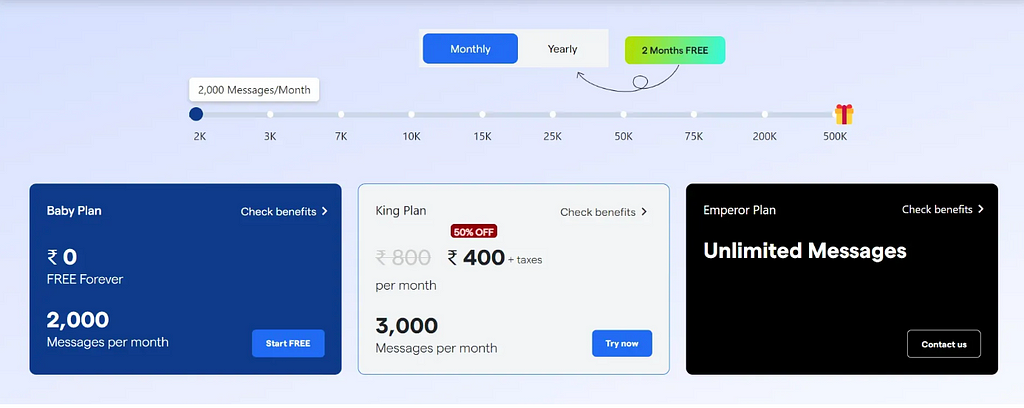
Check out the detailed pricing here Flexible Pricing Plans to Fit Your Needs
SaaS chatbot creators cater to businesses of all sizes with scalable pricing models. Whether you’re a startup or an enterprise, there’s a plan that aligns with your needs and budget.
Pay-as-You-Go Models & Scalable Features
Pay-as-you-go options and the ability to scale features up or down ensure that organizations only pay for what they need when they need it.
Cost-Effective Alternative to Traditional Development
Creating a chatbot from scratch can be prohibitively expensive. SaaS chatbot platforms offer a more affordable solution without sacrificing quality or functionality.
Reason 3: Powerful Features & Integrations
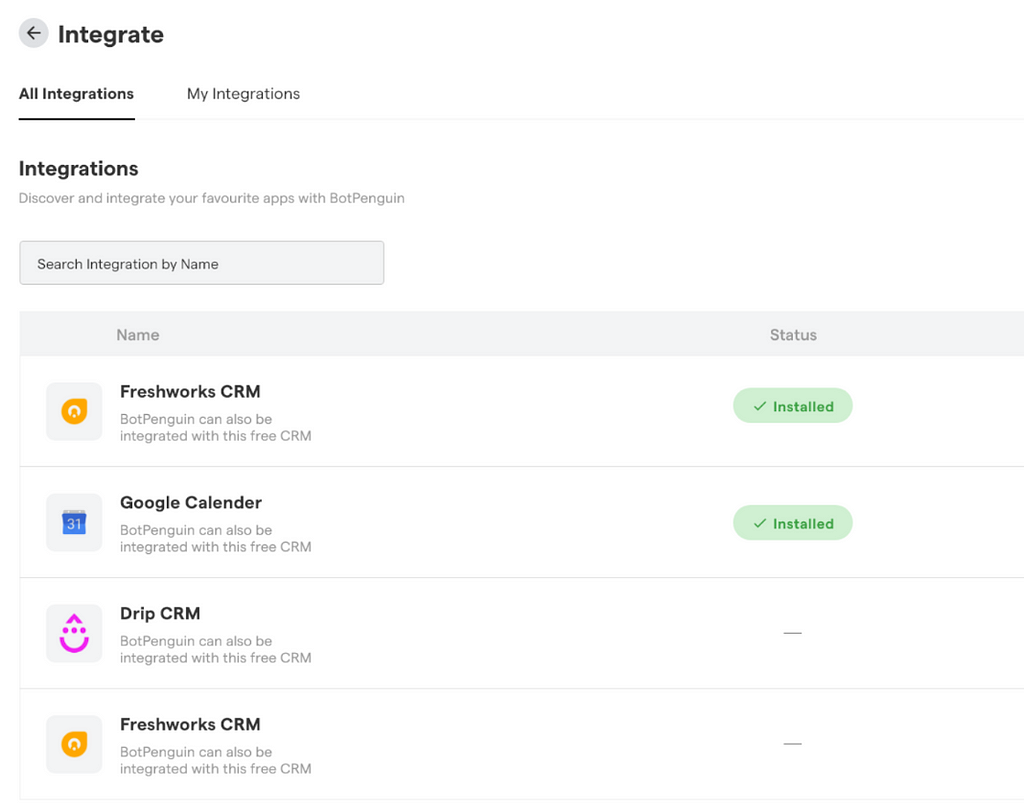
AI-Powered Chatbots with Natural Language Processing (NLP)
SaaS chatbots leverage advanced NLP to understand and interpret human language, allowing for seamless interactions that feel natural and engaging.
Seamless Integration with Existing Tools & Platforms (CRM, Helpdesk)
SaaS chatbot creators ensure their products can integrate with existing business systems such as CRMs and helpdesk software, creating a cohesive technology ecosystem.
Advanced Features Like Lead Qualification & Sentiment Analysis
Today’s SAAS chatbot tools are equipped with features for sophisticated tasks such as qualifying leads based on conversation data and analyzing the sentiment behind customer responses.
Reason 4: Increased Focus on Customer Experience (CX)
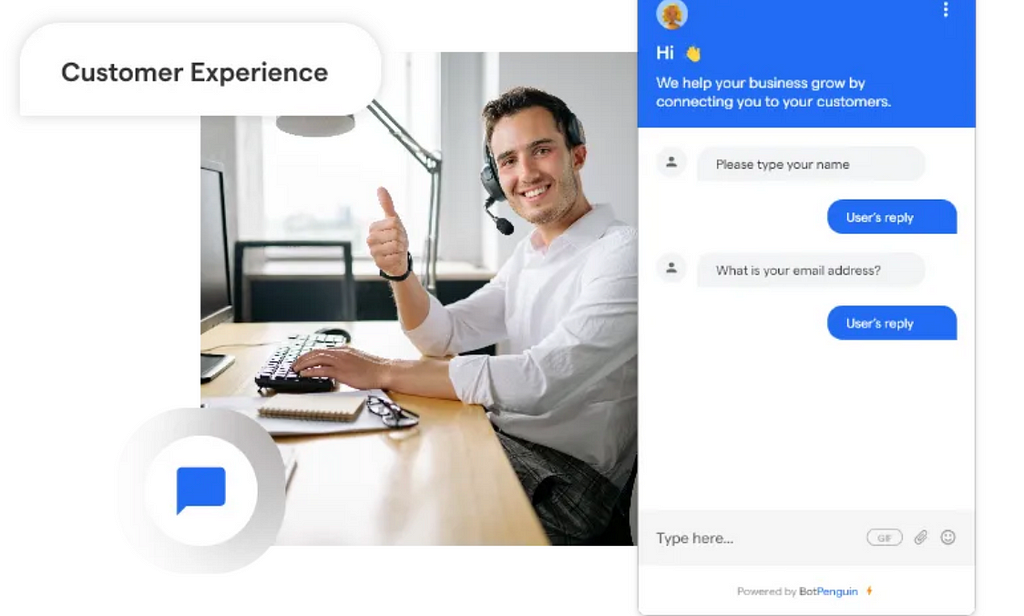
Importance of Customer Satisfaction
In the current climate, a focus on customer experience is paramount for business success. SaaS chatbot solutions play a crucial role in delivering exceptional customer service.
Chatbots Deliver Personalized & Proactive Support
AI chatbots enhance CX by providing tailored support and initiating conversations with users, ensuring that each interaction is as helpful and relevant as possible.
Improved Customer Journeys & Brand Loyalty
By streamlining the customer journey through SAAS chatbot interactions, businesses can foster stronger relationships and deeper brand loyalty.
Reason 5: Data & Analytics to Drive Growth
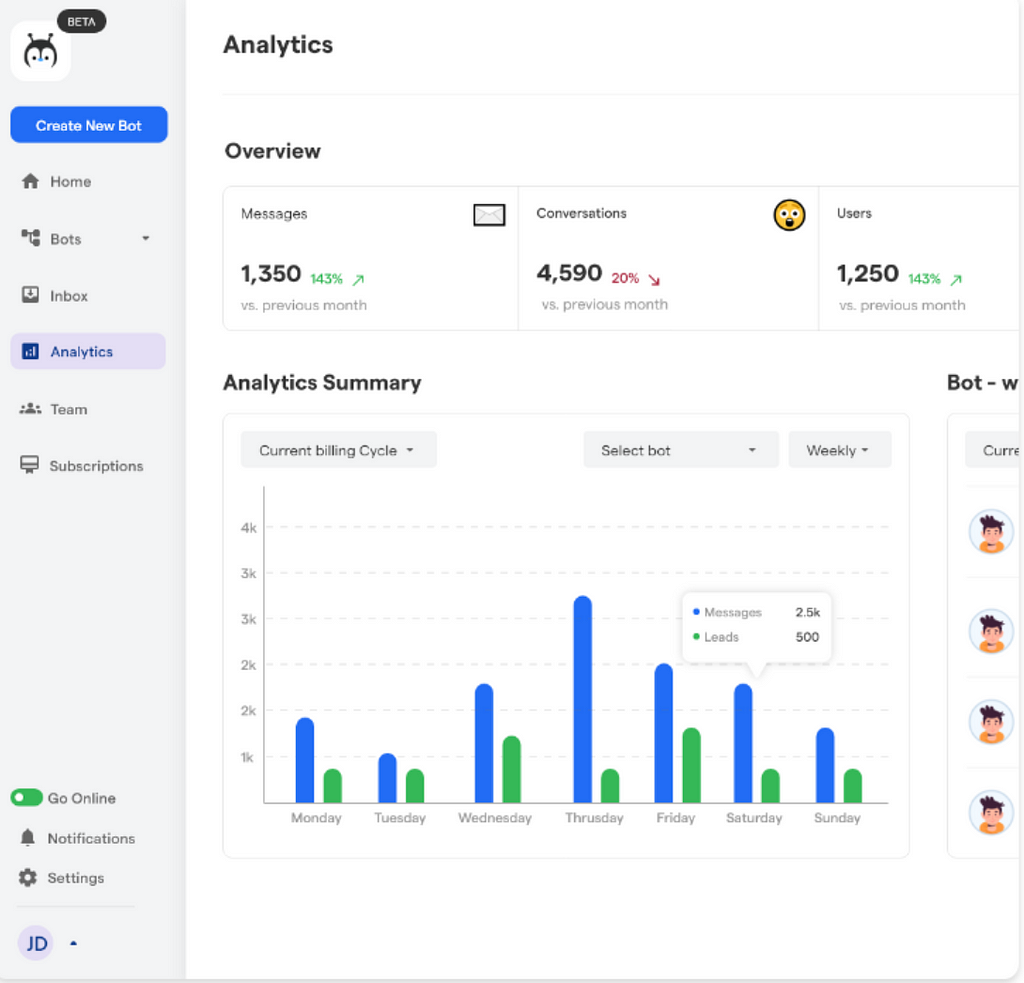
Track User Interactions & Identify Improvement Areas
Analytics features in SaaS chatbot platforms allow businesses to track interactions and identify patterns, pinpointing areas for improvement.
Gain Valuable Customer Insights & Optimize Performance
The data collected by SaaS chatbot creators offers invaluable insights into customer preferences, enabling businesses to fine-tune their strategies and optimize AI chatbot performance.
Data-Driven Decisions for Continuous Improvement
Armed with comprehensive analytics, businesses can make informed, data-driven decisions to continuously refine their chatbot strategies and achieve ongoing growth.
Opting for Botpenguin’s SaaS Chatbot
Alongside the options available in the market, Botpenguin offers a compelling choice for businesses looking to implement a SaaS chatbot tool.
Conclusion
The evolution of AI chatbot makers will bring even more sophisticated AI capabilities, driving unprecedented levels of personalization in customer interactions.
Expect to see SaaS chatbot creators facilitating omnichannel experiences, allowing businesses to have consistent conversations with users across multiple platforms.
SaaS chatbot providers allow customers to visualize dialog flows, train bots with simple messaging, and expose analytics dashboards automatically with no DevOps needed.
5 Reasons SaaS Chatbot Creators Are Trending was originally published in Chatbots Life on Medium, where people are continuing the conversation by highlighting and responding to this story.
